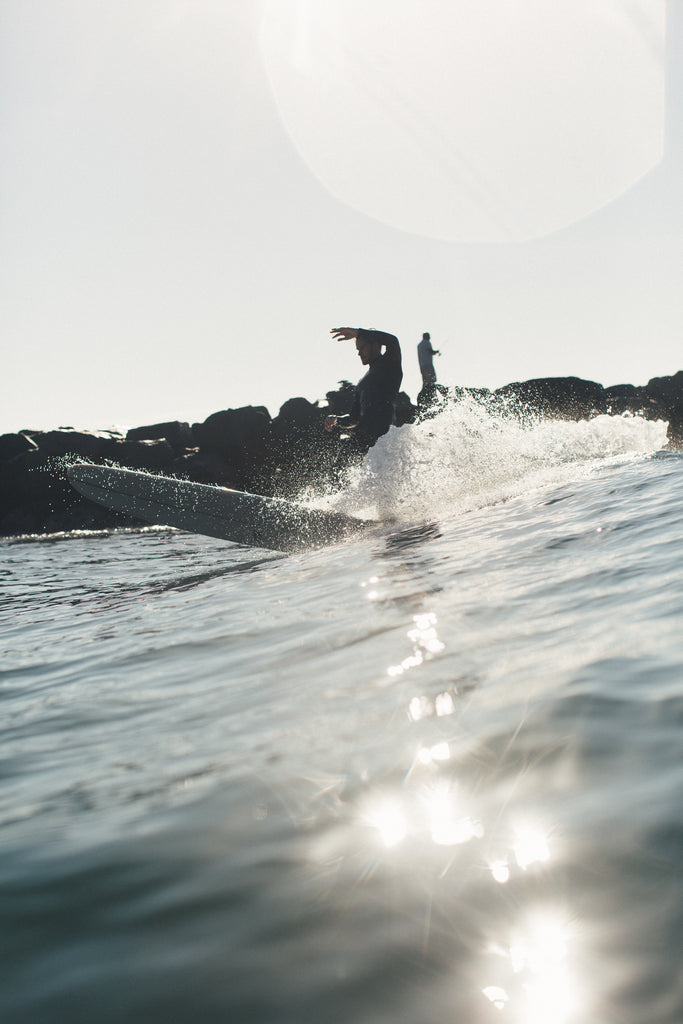Fin selection and fin placement are paramount for maximizing your equipment. Adding the right new fin can unlock your longboard in eye-opening ways. And conversely, putting the wrong fin in your board will result in your board and your fin fighting each other—usually resulting in a clumsy surf experience.
First, we are going to talk about fin selection. Then, we'll touch on fin placement.
When deciding which fin to pair with your favorite longboard, one portion of the board's shape will determine what style fin you need—the tail. (If you want to do a little extra credit, read The Tail Tells the Tale.)
PINTAILS
For Pin Tails, or tails with a lot of curve to them (think: Pinwheel, Joy, Cash-Yew II, or Sano Special) you must have a fin with more rake. Rake is a term for how swept-back a fin is. See below:

The Rake of a fin allows the board to flow through turns, while maintaining speed. This type of turn pairs with boards that have more curve in the outline of the tail.
For example, the curve in the outline of a pintailed longboard allows the board to make arcing cutbacks through the water, and this is assisted by the swept-back rake of a 10.5" Pin Fin. See below:

Nathan Adams is using the rail of his Sano Special and the rake of his 10.5" Pin Fin to push his board through an arcing turn, while maintaining his speed and flow.
SQUARE TAILS
Boards with Square Tails turn entirely differently than curvier-tailed boards.
Boards with square tails pair better with fins that have less rake, like the 10" Huck Fin, the 9.75" Dee Fin, or the 10" Log Rhythm Fin. Those fins work great on boards like the Lumberjack, Walks on Water, and Logistic—where the style of turning is more of a swinging-pivot than an arcing redirect.

A 10" Huck Fin in the tail of a 9'6 Lumberjack works like the hinge on a door, when you step back on that tail, you are able to swing the board under your feet, slowing the board down and changing direction in one motion—which is ideal for setting up a board for noseriding.

In this photo, Makala Smith is bringing her Lumberjack and 10" Huck Fin nearly to a stop to redirect and set up for the inside section at Malibu.

Similarly, Wesley Francis stalls and turns his 9'6 Logistic model with a 10" Log Rhythm Fin, allowing him to set up deep in the pocket for the upcoming noseride.
These are examples of proper surfboard & fin pairings, guided by the principals of the tail shape. If you aren't sure which fin would be appropriate for your longboard, use the above rules as a guide, or shoot us a note to confirm your assumptions.
FIN PLACEMENT
Almost as critical as proper fin selection is placement of the fin within the fin box.
As a general rule of thumb:
- When you move your fin back in the box (closer to the tail) the board will feel stiffer, but it will hold in the wave better.
- When you move your fin forward in the box (closer to the middle of the board) the board will feel looser under foot, but be less stable.
For rakey fins and pintailed surfboards, the trailing edge of the fin should end somewhere between the cut-lap and the end of the tail of your board. See below:

For square-tailed boards and less-rakey fins, you actually want the fin even further back. It is not unusual for a Huck fin (or similar) to align with the end of your surfboard's tail. See below:

For these less-rakey fins, moving them too far forward in the box will result in the board wanting to lay-over, instead of turn.
This "back of the box is better" rule is especially true with D-Fins. If you opt to put a Dee Fin in your Surf Thump or classic longboard, you absolutely want to put it all the way to the back of the fin box.
When placing your fin in your fin box, use these above rules as guidelines, but don't hesitate to make small adjustments to see how you like the changes. A little bit of movement goes a long way.













